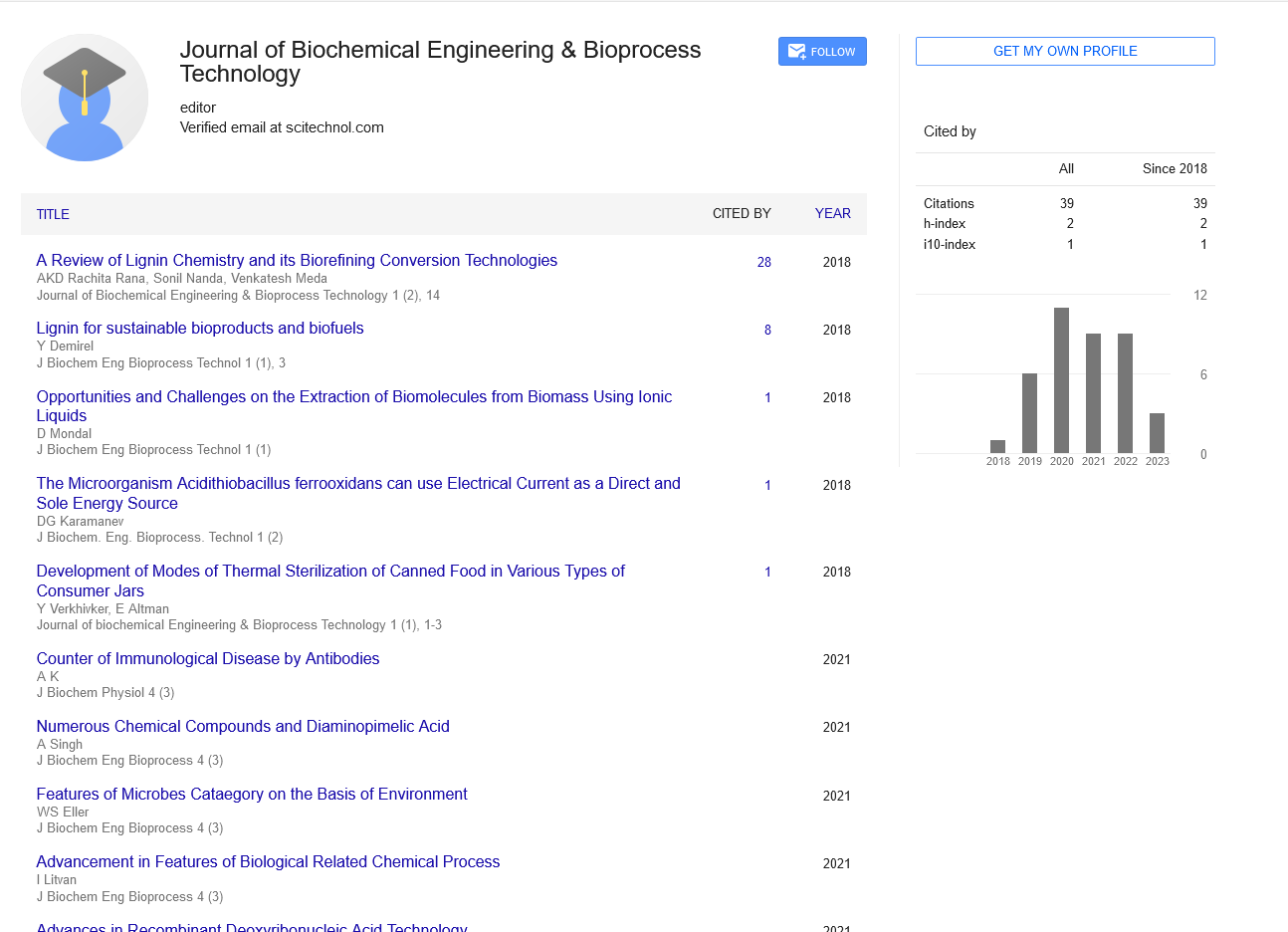Commentary, J Biochem Eng Bioprocess Vol: 11 Issue: 3
Deliberate Deficiencies Expanding Electronic Function
Steven Aris*
Department of Materials Science and Engineering, University of Drexel, Philadelphia, United States of America
*Corresponding Author:Steven Aris
Department of Materials Science and Engineering, University of Drexel, Philadelphia, United States of America
Email: pkathyn@gmail.com
Received date: 23 February, 2022, Manuscript No. JBEBT-22-60080;
Editor assigned date: 25 February, 2022; PreQC No. JBEBT-22-60080 (PQ);
Reviewed date: 04 March, 2022, QC No. JBEBT-22-60080;
Revised date: 11 March, 2022, Manuscript No. JBEBT-22-60080 (R);
Published date: 28 March, 2022, DOI: 10.4172/jbebt.100044.
Citation: Aris S (2022) Deliberate Deficiencies Expanding Electronic Function. J Biochem Eng Bioprocess 5:2.
Abstract
Stoichiometry in the traditional feeling of Proust is improper for zeolites. The wide scope of substance organization of zeolite have structures and the huge assortment of layout and sorbate atoms makes it hard to portray zeolites in compound equation units. Zeolites are not non-stoichiometric compounds since this term is utilized for materials with particles in various oxidation states and thus, changing measures of charge repaying counter particles. Zeolites are composite materials on the nuclear scale with an obvious host system and customizable measures of visitor atoms. The organization of the host system may be considered as strong arrangement series of T-molecules of various nature tetrahedrally planned by oxygen. Zeolites are ordered in structure types portraying the geography of the system in a three letter code no matter what its creation or production. On the opposite side, a wide assortment of material names represent one zeolite have structure type having a particular synthesis or arrangement range. In any case, there is no rule characterizing the visitor particles or potentially allotting it to a material or design type. The non-structure constituent may be a cation, an anion, both hydrated or got dried out, a water particle or a nonpartisan natural or inorganic atom. In this setting formats are those no framework constituents which are utilized as construction balancing out species for the combination of zeolites. Nonetheless, typically metal cations are prohibited when one discussions about layouts. Sorbates are those visitor particles which are stacked onto a host structure after calcination of the amalgamation item. Water is a sorbate, be that as it may, is most frequently not considered to assume a significant part during combination as format. Viewing at zeolites as host-visitor frameworks the host structure is the tetrahedral network worked from visitor particles and so forth units.
Keywords: Cation Movement
Electronic Fermi-Level Flimsiness
Surface stoichiometry scattering of the metal oxide grains might be as significant a boundary in gas-detecting and photovoltaics as film thickness and grain size. This measure decides the adsorption capacity and the surface charge through the quantity of oxygen opening and accordingly, controls the underlying surface band twisting of the metal oxide and the difference in the substitution of the encompassing gas. Taking into account that stoichiometry straightforwardly affects such useful gadget attributes as responsiveness, selectivity gas detecting and reproducibility of electrochemical responses, it should be precisely controlled. Note that stoichiometry is equivalent to stoichiometry pattern, albeit the objective particle is unique. This possibility was not represented in the stoichiometry definition. Since the whole number slices are composed to keep any stoichiometry from happening at least a couple of times, no stoichiometry creating species were found and stoichiometry was added physically subsequent to tackling the issue. On a basic level, the whole number slices could be changed to keep away from this issue by including data to recognize the objective atom, so that main rehashed stoichiometry's used to create a formerly designated particle are rejected. Every one of the five laid out sciences displayed were recreated; stoichiometry an addressing the isomerization of methyl format, stoichiometry addressing the carboxylation of methanol, stoichiometry addressing the oxidation of n-butane and stoichiometry's and addressing the oxidation of acetaldehyde and butanes separately, if in fairly diminished structure for example without the consideration of intermediates. While the carbonate course enjoys many benefits, it experiences a few disservices
Cation Opening Movement
There is available all through the polymerization a limited convergence of phenolic hydroxyl bunches not yet changed over to phenoxide. These acidic circumstances might cause disintegration and the biphenyl itself might go through deterioration, especially on the off chance that the response temperature is raised too quickly. The development of water fume and carbon dioxide might create frothing issues this is tried not by expand the response at explicit hold temperatures. The strength of intricate oxides with surprising stoichiometry is accounted for to emerge from an electronic Fermi level flimsiness as opposed to due to accidental non-stoichiometry from restricted engineered capacities. This understanding is utilized to foresee compounds with tunable optical straightforwardness and conductivity. Observe high convergences of cation opening structure exothermically in degenerate yet gapped straightforward directors due to a fermi-level precariousness that is taken out by the rot of electrons from the conduction band into opening shaping electron acceptor states. The cation opening movement the Fermi level while additionally catching electrons in the imperfection levels they produce. The inner band hole and termination of anti-bonding states gives the main impetus to proceed with arrangement of cation opportunities, which ostensibly stops while bond-breaking and strain energies become similar to the active energy acquired by filling those acceptor states.
 Spanish
Spanish  Chinese
Chinese  Russian
Russian  German
German  French
French  Japanese
Japanese  Portuguese
Portuguese  Hindi
Hindi 